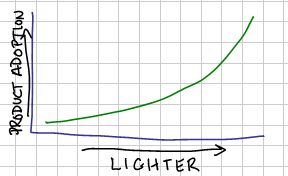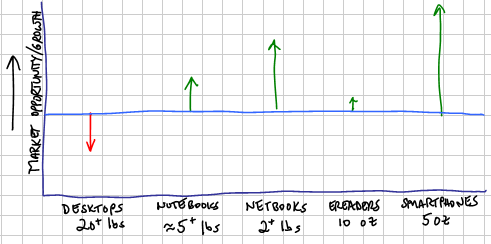What if a Tablet PC was as light as a legal pad? Would you use it more? Would it become the first thing you grab for? Or would paper still be a strong challenger? I think the lighter Tablet would win out.
Weight matters.
Assuming all other things being equal, same price, same size, same battery life, same software, in fact, I think there’s a relationship between weight and product adoption. Line up all the personal computers that people use today from heaviest to lightest and I think a trend reveals itself. The lighter devices gain greater adoption. My theory is that there’s an exponential relationship between product weight and user market size–given all other things equal (which of course, it isn’t in reality, but suspend your skepticism for a bit):
Now, even though all things aren’t equal and there’s a large legacy of devices and user behaviors with older bulkier equipment that skews this idealized graph, I think there’s still a trend towards lighter devices. Take desktops today, for instance. They’re in the 20 plus pound range. This past year in the US there was a decrease in growth for devices of this class. Next up are notebooks, starting at around 5 pounds. Today we’re seeing strong growth in this area. Following this are Netbooks, which are even lighter, in the 2 pound range. The growth here is quite significant, in part due to price, of course. Following this are cell phones and devices like the iPhone and iPod Touch. Weighing in at 5 oz or so we see a huge growth rate.
OK, you’re thinking this is just an argument benefitting from Moore’s Law. Could be. I’m not making any claims. I’m just thinking that if weight is such a big attractor to people and is part of their visceral experience in using a device that it would make sense to design for it. What do I mean? I mean if you look at the graph you’ll see a hole around the under 1 lb mark. There really aren’t many computing devices in this space. The eReaders I think have the greatest chance of breaking out in this weight class as we’ve somewhat seen by the Kindle. In fact, done right I think this is probably where the next break out device will be. Yes, they could be in a new category of even lighter 1 oz devices, but I think evolution being what it is, I’m going to go with the eReader-class device concept. If you look at this device-by-weight chart you can see that’s the category of device where there’s “less than expected” growth.
Now here’s the thing about eReaders. They really are just like any other computing device, but they have some sacrifices. Most of these sacrificies are geared around the eInk display and its bias towards static reading rather than dynamic animation or interaction. After thinking about it a bit, I think this tradeoff is a reasonable one for the most part. The problem is that they really need more interaction or at least support for bursty interaction. For instance, an eReader that allows for fluid user pen input is one step in the right direction. There doesn’t need to be much animation or video support or Flash-style content rendering, just the ability to handwrite let’s say the solution to a math problem or to draw a sketch or color a picture and so on. To begin with animation isn’t necessarily crucial, but ease of input is.
With the incremental addition of input like this I think you now open up the eReader market to schools as a very competitive computing platform. Why? Because an eReader mirrors the traditional book model of school content and with the ability to write on an eReader as if it were paper, you cover the paper model too. Typing can still be supported, as it is in the Kindle or on cell phones, but to begin with the bias doesn’t have to be towards keyboards either. Why? Because again it’s a reading oriented device, not a heavy content oriented device. Typing or handwriting would be bursty.
OK, so now you’re wondering why a student would want a keyboard crippled computer rather than a full-blown clamshell like device they can carry with them? For college students I agree. They generate keyboard content too much. The younger the student though, this is not the case and this is the pattern that points to an eReader device rather than a traditional keyboard-based PC.
The closer you get to K in K-12, the more ideal an eReader with paper-and-book-oriented interaction is. Does this mean that at some point, let’s say 6th grade, that students would switch from an eReader like device to a clamshell like notebook? Could be. However, even when they do, they will still read and from this viewpoint the eReader will still have compelling value. And it doesn’t take much to envision a more advanced adept student using an eReader and computer at the same time–one for reading or taking notes, one for writing.
In Part 2 I’ll go into the rationale for thinking in terms of an eReader-like device as the next big opportunity for general purpose computing devices, till then, I’ll go back to my premise: Give people a lighter weight device in the same or less price point and you have potential for a growth market.



You are spot on. I am reading this and responding to it now because I had my OQO in my pocket. I decided to have a cigar before braving the evening commute and I pulled out the OQO to catch up on my RSS feeds.
One pound of connect anywhere tablet goodness.
The importance of pocketability and portability cannot be overstated.
What’s interesting to me is how the modern electronic computer revolution started in 1942 with the ENIAC weighing in at 30 tons. Can you imagine one of those in every household? 🙂
Every household? Somewhat more than IBM Chairman Thomas Watson envivioned when he said (in 1943) “I think there is a world market for maybe five computers.”
For kicks I calculated the cost per pound of the devices I listed earlier plus the ENIAC. Outside of the Netbook, the numbers show that people are willing to pay a premium for less weight.
ENIAC approx $8/lb
Desktop $50/lb
Notebook $300/lb
eReader $560/lb
iPhone $1,280/lb
Kind of interesting that this trend has held up over the years, going all the way back to the ENIAC 🙂
The Netbook is only at about $180/lb which comes out somewhere between the typical desktop and the notebook. You might think it should actually be a premium between the notebook and eReader. Well, because of price it’s not, but guess what? UMPCs fall exactly into this price per pound curve and we all think they’re overpriced, right?
Now maybe over time notebook prices in general will adjust down to where the Netbooks are. I hope they do. I think that’s really the lesson here. It’s not that Netbooks are so underpriced for their weight category. It’s that notebooks are too high for their weight.